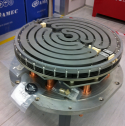This is news from last December.
"HP, aka Hewlett Packard, is one of the most well-known tech companies in the world. They produce nearly every product you can think of: laptops, desktops, printers, enterprise hardware, and solid-state drives.
For their SSD storage products, HP teamed up with BIWIN Storage, a large Chinese OEM for SSD solutions with 25 years of experience in the storage and microelectronics business. BIWIN were granted authorization from HP to produce SSDs in their name.
...
The HP FX700 is the first solid-state-drive we have tested that's built using QLC NAND flash from YMTC, in the new 232-layer variant, which is an impressive technological feat, because China's flash memory manufacturing has caught up with Micron and Hynix. For the controller the Maxiotech MAP1602 is used—we've seen it on several highly affordable drives recently. As expected, a DRAM cache chip is not included, just like on other MAP1602 drives, to reach the targeted price point."
"HP, aka Hewlett Packard, is one of the most well-known tech companies in the world. They produce nearly every product you can think of: laptops, desktops, printers, enterprise hardware, and solid-state drives.
For their SSD storage products, HP teamed up with BIWIN Storage, a large Chinese OEM for SSD solutions with 25 years of experience in the storage and microelectronics business. BIWIN were granted authorization from HP to produce SSDs in their name.
...
The HP FX700 is the first solid-state-drive we have tested that's built using QLC NAND flash from YMTC, in the new 232-layer variant, which is an impressive technological feat, because China's flash memory manufacturing has caught up with Micron and Hynix. For the controller the Maxiotech MAP1602 is used—we've seen it on several highly affordable drives recently. As expected, a DRAM cache chip is not included, just like on other MAP1602 drives, to reach the targeted price point."
Last edited:



